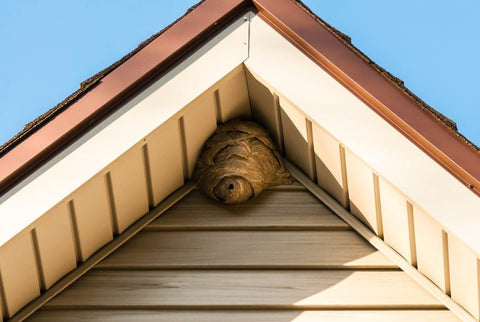Having stinging insects flying around your space can be worrisome. These pests often build nests in yards and homes. Locating the nest is one of the first steps to eliminating an infestation. We’ve gathered information to help you identify and locate wasp nests.
What Do Wasp Nests Look Like?

When you’re searching for a wasp nest, you need to know what they look like. Stinging insect nests will vary in appearance depending on the species. Check out how to identify common stinging insect nests.
- Paper Wasp: Nests are made from plant material and have a paper-like appearance. They are typically gray or brown. Paper wasp nests are shaped like an umbrella.
- Hornet: Like paper wasp nests, hornet nests are paper-like and gray. They have a teardrop shape. These nests are known for having one round entry point.
- Mud Dauber: These stinging insects construct nests with mud. Some nests look like cylinder-shaped tubes. Other nests resemble small pots.
- Yellow Jacket: Yellow jacket nests are often found underground. The entrance is marked by a round hole. Sometimes these pests build nests above ground, and their nests also have a paper-like appearance.
How to Find a Wasp Nest

Now that you know what wasp nests look like, you can begin your hunt for them. Here are a few tips to help you find the nest.
1. Watch the Flight Path
Adult wasps leave their nests in search of food for themselves and the larvae. When you spot these pests flying around, try to watch their flight path. If you follow them, they will usually lead you to the nest. These stinging insects are typically active during the day and head back to the nest at dusk. Try to catch them before they return to the nest.
2. Listen for Them
You’ve probably ducked out of the way when you’ve heard the buzzing of a bug. Wasps are known to produce buzzing noises. The sound will be more noticeable in larger colonies. You can use this to your advantage and try to find their nests by following the noise. If wasps are living in your home, they may make tapping noises when constructing a nest.
3. Check Common Nesting Spots
If you’re having trouble following the wasps, you can examine common nesting areas. There are several places where wasps are known to build nests. These pests prefer shaded and protected spots outside and undisturbed spots in your home.
Common nesting spots include:
- Shrubs and bushes
- Trees
- Underground at the base of trees
- Cracks in the sidewalk or pavement
- Sheds
- Porch ceilings
- Under decks
- Eaves
- Attics
- Doorframes and windowsills
- Wall voids
How to Get Rid of a Wasp Nest

Using a plant-based insecticide spray can help you eliminate a wasp infestation. Our Wasp & Hornet Killer is a foaming jet spray that reaches up to 18 feet. It can be used outdoors or in unfinished areas of your home. You can carefully coat the nest starting with the entry point and then spraying the rest of the nest. If there are wasps near the nest, you can spray them too. Our Wasp & Hornet Killer kills and repels these pests. Remember to be careful when treating wasp nests. If you are allergic to stinging insects or are dealing with a large infestation, you can always contact a professional.
Wasps don’t make the greatest roommate. Knowing how to locate their nests can help you keep your home and yard wasp-free. If stinging insects are bugging you, we have your back! Check out our Maggie’s Farm Simply Effective™ Pest Control products for a more environmentally and family-friendly solution when used as directed.
